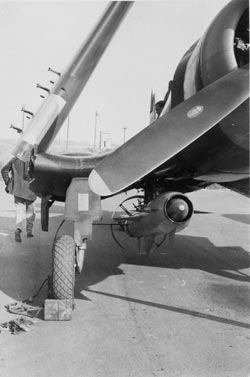|
Vought’s first missile
 In 1946, the term “missile” was not in general acceptance. The Navy called their projects “Pilotless Aircraft” (PA). One of these, the PA-6 program, was among the 18 study contracts issued by the U.S. Navy to 12 aircraft manufacturers. The PA-6 program was a study contract to evaluate short-range surface-to-surface missiles. In 1946, the term “missile” was not in general acceptance. The Navy called their projects “Pilotless Aircraft” (PA). One of these, the PA-6 program, was among the 18 study contracts issued by the U.S. Navy to 12 aircraft manufacturers. The PA-6 program was a study contract to evaluate short-range surface-to-surface missiles.
The Navy was convinced that guided missiles would become desirable weapon systems for ships and submarines. The study contracts were aimed at getting the aircraft manufacturers interested in the new missile technologies.
Winning this contract was Vought’s entry into the missile business. The contract was felt to be highly desirable as it was a way to enter the “high tech” area of supersonic airspeeds. The contract was signed in June of 1946, and within Vought was designated V-349. Another contract was soon to be available but it was for an air-breathing engine, and did not “push the envelop” as much as PA-6 did.
Although the ultimate missile was large, the flight-test program began in March 1947 with several drop tests of the ¼ scale models, mostly inert. Inasmuch as there was no suitably sized ram-jet available, the propulsion was limited to an off-the-shelf rocket booster manufactured by Aerojet General. The full size ramjet was under development by Marquardt.
The body of the missile was adapted from a piece of steel sewer pipe. Flying surfaces and inlet edges were razor sharp. There was an airborne telemetry system but the only true test instrumentation was confined to some internal pressure rakes to provide air-flow data for the future ramjet engine.
 The flight profile required a free-fall drop from an F4U at 25,000-foot altitude, followed by ignition of the booster while the pilot of the F4U broke away in a severe high “g” maneuver to ensure his safety. The flight profile required a free-fall drop from an F4U at 25,000-foot altitude, followed by ignition of the booster while the pilot of the F4U broke away in a severe high “g” maneuver to ensure his safety.
The test pilot was less than wildly enthusiastic when told that almost 8 percent of these boosters exploded on ignition. The high “g” escape maneuver required the pilot to be fitted with a special g suit not then in common use.
The missile was dropped with a long lanyard trailing back to the F4U. When the cable pulled tight the booster motor ignited. The missile was to accelerate to 1.25 Mach in 2 seconds.
After two drop tests, the contract with Vought was canceled and further development of the PA-6 was given to Grumman where the missile became known as “Rigel.” After four launches, the Grumman contract was canceled.
In the meantime, Vought submitted a proposal to develop a subsonic surface-to-surface missile using a state-of-the-art turbojet engine propulsion system. This represented the “low-tech” path that Vought did not initially prefer, but this was what the Navy wanted to do to get an early entry into guided missiles. A contract for this missile was issued to Vought in November 1947 and the program ultimately known as “Regulus” was begun.
|